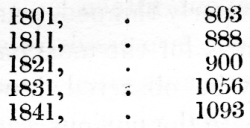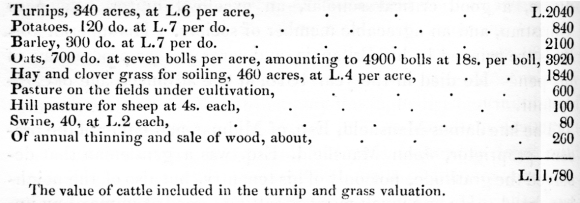|
PRESBYTERY OF KINCARDINE
O'NEIL, SYNOD OF ABERDEEN.
THE REV. GEORGE COOK, MINISTER.
[Drawn up by the late incumbent, the Rev. George Middleton. ]
I. Topography and Natural
History.
Name, Boundaries, &c.—The
name of this parish appears to be derived from the Saxon word Mid, and the
Gaelic word Marr, signifying a black forest.
Extent, &c.—The parish is
nearly 7 miles long from east to west, and about 5½ broad from south to
north, in some places, and in others not above 4½. It is bounded on the
east by the parish of Echt; on the south, by Banchory Ternan and
Kincardine O'Neil; on the west, by Lumphanan and Cluny; and by Cluny on
the north.
Topographical Appearances,
&c—The surface of the parish is very uneven, being elevated into two hill
ridges, and of course depressed by their accompanying vales. Between the
ridges flow rills or small burns from west to east. The ridges are of so
gentle acclivity as to offer no obstacle to the plough from the bottom to
the summit, and, if properly tilled, produce very fair crops, both green
and white, unless where the soil is so thin as not to admit of ploughing.
In that case, it is planted with Scotch firs, which thrive better than
could well be expected from such meagre material, add considerably to the
beauty of the country, afford shel-ter for the cattle, and tend
considerably to improve the climate. These ridges slope to a level as they
proceed towards the west end of the parish ; both, however, emerge
suddenly from their depression to eminences considerably loftier than
those from which they descend. In the north-west end of the parish, there
are two or three farms, of which several parts of the arable fields are
between 700 and 800 feet above sea level, but most of the farms in the
parish are, on an average, about 460 feet above sea level. Though there
are many eminences in the parish, yet there is not one in it but the hill
of Fare that deserves the name of a hill. It rises about 1800 feet above
the sea. On the north side of this hill, along its bottom, are between 400
and 500 acres of arable land, mostly of good quality. The Castle of
Midmar, the seat of John Mansfield, Esq., is placed on the north side of
this hill, at 300 feet from its base. The view towards the north and
north-east is extensive. The scenery is very beautiful, owing to the
alternate eminences and valleys which are interspersed with shrubs and
trees of various kinds. Of the time at which it was built, there is no
historical account. Tradition informs us, that part of it was erected by
Sir William Wallace, when Governor of Scotland, as a hunting-seat for his
friend, Sir Thomas Longavale.
Geology and
Mineralogy.—Granite and whinstone are in abundance, both in blocks and
quarries. The granite is beautiful, and capable of a fine polish. Some of
the stones are from eight to ten feet long, and are very useful for
lintels, and ornamental in building.
Soils.—Though much has been
done of late to correct and improve the soil, yet there remain still
several patches of marshy ground, inclined to moss, to employ the
ingenuity and industry of the active agriculturist. As a spirit of
improvement is at present the order of the day, it is to be hoped that
remaining defects and blemishes will soon be removed. Where the hilly
ridges towards the west end of the parish slope into the valley or level,
there predominates a thin soil of sand and clay, slightly mingled with
loam, resting on a subsoil of gravel. Of this character is a great
proportion of the land lately brought under cultivation. The quantity of
improved marshy ground is still yearly increasing.
Hydrography.-—Though this
parish is well supplied with perennial springs and rills of fine water,
there is no stream deserving the name of river, or even rivulet. There are
several chalybeate springs, formerly esteemed for their effects in
removing scorbutic complaints; but now they are rarely resorted to.
Botany.—In 1808-1809, there
were about 2 10 acres only under wood. Now the plantations, under trees of
various kinds, amount to about 1400 acres, properly thinned, pruned, and
thriving. The clumps and hedgerows are, for the most part, judiciously
laid down and kept. Here it may be observed, however, that too little at-tentioji
is paid to extirpate the noxious weeds that, in many places, infest the
fields, offend the eye, and prove inimical to the crops of grass and corn.
II.—Civil History.
Parochial Registers.—These
consist of the kirk-session minutes, earliest date, 17th April 1768;
records of baptisms, 22d September 1717; records of marriage-contracts,
earliest date, 18th October 1718.
Land owners.—Of these are
four: John Mansfield, Esq. of Midmar, who possesses the most extensive and
valuable estate in the parish; Mrs Duff of Corsindae has the next in
extent and value; Colonel Gordon of Cluny lately purchased the estate of
Shiels; Mr William Davidson is proprietor of Kebbaty. The only residing
heritors are Mrs Duff of Corsindae, and Mr Davidson of Kebbaty. The former
may be said to reside only occasionally.
Eminent Men.—Under this
head we may mention the Rev. John Ogilvie, D. D., the late incumbent, and
predecessor to the present minister of the parish. He was allowed to be an
able divine, a good critical scholar, an excellent orator, a sincere
Christian, and an agreeable member of society. His superior abilities are
evinced by his Britannia, and several other productions of his pen. He
died in the year 1813, at the advanced age of eighty-four.
The late James Mansfield,
Esq. of Midmar, and father of the present proprietor, John Mansfield, Esq.
was a gentleman that deserved the gratitude, not only of his tenantry, but
also of the neighbourhood. He had much merit in setting a good example of
an improved style of husbandry, and liberally contributing to promote its
advancement. From the most wretched and sterile condition imaginable, in
which he found his property in Midmar after making the purchase, he
brought about 500 acres most contiguous to his dwelling to resemble a
flourishing garden, and these he set apart for his home-farm. When he
began his agricultural operations, so rugged, wild, and barren were most
of the fields, as not to be worth 5s. per acre; now they draw from L.1,
10s. to L.2. M. James Mansfield died in 1823, much and justly regretted by
his tenantry, and a wide circle of friends and relatives.
III.—Population.

IV.—Industry.
Agriculture and Rural
Economy.

of which a considerable
extent may yet be brought under the plough, and planted with advantage.
The crops raised generally
are oats and barley. The green crops are turnips and potatoes. The
duration of leases is nineteen years, which is too short a period when
expensive improvements are undertaken. The most common complaint, however,
among the farmers, is the low price of grain, which renders it very
difficult to meet the term of payment of rents, servants' wages,
tradesmen's bills, &c. without encroaching on their capital.
Produce.—The average gross
amount of raw produce raised in the parish, as far as can be ascertained,
is as follows:—

Rent of Land.—The average
rent of land may be said to be L.1, 5s. per Scotch acre of the ordinary
quality. Some of it, however, is not worth above 5s. per acre, and other
fields draw upwards of L.2 per acre.
The real rent of the parish
is about L.3000; the valued, L.2387 Scots.
Breeds of Live-Stock.—The
number of black-cattle of all ages, about 1420; of horses, 170; sheep,
730; swine, 40. The keep of a cow per annum is valued at L.4; an ox, at
L.3, 3s.; young cattle, L.1, 10s.; a full-grown sheep on hill pasture, 4s.
V.—Parochial Economy.
Aberdeen, which is about
fifteen miles distant, is the nearest market-town. Thither our farmers
drive all their grain and farm-produce. The corn-merchants attend the
Aberdeen weekly markets to purchase grain, and when there is a brisk
demand, they send their agents through the country to buy for them, and
allow about 6d. for the boll or quarter.
Ecclesiastical State—The
church was built in 1787. It accommodates about 600. It is rather too near
the south side of the parish, and, by consequence, rather too far from the
north, especially during the winter time. The sittings are free, the area
being divided among the heritors according to their valued rents, for the
accommodation of their tenantry, who are in general very well provided
for. The average number of communicants is 470. Public worship is well
attended, and the congregation make a very decent appearance on the
Sabbath day. The manse is old, and it is not known when it was built. It
has undergone several repairs within these twenty years, and it is very
insufficient at present. [A new manse was built in 1840, nearly on the
site of the old.] The glebe, including the stance of the manse, offices,
and garden, consists of 12 acres, 3 roods, 2 falls Scots measure. It may
be valued at L.25 yearly. The stipend, as modified 13th and 27th February,
commenced with crop 1829. Meal, at eight stone per boll, 49 bolls, 3
firlots, 1 peck, 3 8/10 lippies; bear, Linlithgow measure, 3 bolls, 1
peck, 2¼ lippies; money Sterling, L.186, 6s.
Education.—In the parochial
school, the branches of instruction taught are, English grammar, writing,
arithmetic, geography, practical mathematics, and Latin. The parochial
teacher has the legal accommodation, and the medium salary, and his school
fees may amount to about L.30 a-year; the session-clerk's salary and other
dues, such as marriage proclamations, &c. may amount to about L.4. The
average number of scholars attending the school annually may amount to 70.
There are one or two Sabbath schools in the parish. [There is now a large
and select parish library, which is much resorted to.]
Poor and Parochial Funds.—
There are 17 or 18 on the poor's list. Our Sabbath collections amount to
about L.30 annually, exclusive of the public collections for the Aberdeen
Infirmary, and collections for Highland Schools and Foreign Missionaries,
&c.
There were L.200 belonging
to the poor, which had been deposited in the hands of one of the heritors
of the parish, who failed, and paid only at the rate of 3s. a pound. No
assessment has as yet been imposed on the parish for relief of the poor;
but something, it is presumed, must soon be done for the support of an
overgrown class of paupers.
There are on the skirts of
the parish two Dissenting congregations; the one consisting of the United
Associate Seceders, the other of the Original Burgher Associate Synod.
Both are mostly made up from neighbouring parishes. [The latter has now
joined the Established Church, and their clergyman is a member of
Presbytery.]
Miscellaneous Observations.
Since the last Statistical
Account was written, not only the population has greatly increased, but
the land rents have advanced from about L.1100 to about L.3000, and, I
believe, from good authority, they are more punctually paid; while most of
the farmhouses have been rebuilt, enlarged, and improved, and the
office-houses are on a much better plan. A considerable extent of the
fields is inclosed with stone dikes and improved; turnpike and parochial
roads have been made and are kept in good repair; stagecoaches pass and
repass daily. Many acres of moory and marshy ground, that were useless and
even offensive, are now producing remunerating crops of corn, grass, and
trees of various kinds.
Revised May 1842. |

